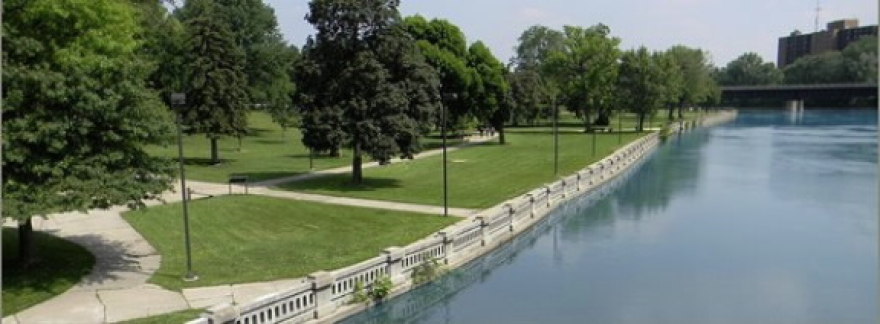The river is one of those things we mostly take for granted. Today on Michiana Chronicles, Sid Shroyer takes a closer look.
The St. Joseph River is the watershed of most of what we call Michiana. Like the more famous Charles, Hudson, and Potomac, it’s an end-of-the-road river. It carries its own water all the way to the Sea of the Great Lakes. Best, it’s ours. It’s an unobtrusive, patient friend. It’s a tranquil back yard or a porch we share.
I like having our St. Joseph River, just four blocks from my house, with a tree-lined trail for walking and biking that I’ve been using for 20 years. From IUSB I can bike west and then north through South Bend, and, with a couple of zig-zags, follow the river past St. Mary’s College on the opposite bank, across Cleveland Road, and all the way up to the old Darden Road bridge. For a shorter trip I can go east next to Northside Boulevard along the river into Mishawaka to Beutter Park.
In Mishawka, there’s new development near the river, new homes behind the 100 Center, some new apartment buildings nearby, and new space for offices; but, with the new park land and the overall layout of things it seems like it’s a priority over there to keep people connected to the river. I hope the planners of new development in South Bend make it a priority to keep people connected to the river. I’m sure they’ve had a look at what’s happening in Mishawaka. Visitors there remark on the subtle beauty with surprise, but the river has been there all along. It takes some effort to see.
“Nature is the symbol of spirit,” says Ralph Waldo Emerson.
It’s good to have some nearby.
The river there at Central Park was a great location, when, after Rosh Hashanah morning services last week, a few of us from Temple Beth-El reconvened with Rabbi Companez to cast our sins into the water. It’s a ritual ceremony called Tashlikh that Jews may perform during the High Holy Days, ten days also called the Days of Awe, which run through Yom Kippur, the Day of Atonement. The pebbles we throw are intended to each represent where we “missed the mark” in the last year.
On my porch, the next afternoon, I began to read the book Rabbi assigned during services. It’s Between the World and Me by Ta-Nehesi Coates. The congregation is being asked to delve into the difficult topic of racism.
The book is a long essay in the form of a letter to Coates’s 15-year-old son about what it means to live as an African American. “Race is the child of racism, not the father,” Coates tells his son.
I get it, I think. Hate invents its rationale. Then it rationalizes itself with its own invention. He is writing to me, too, a 63-year-old European American. The idea of race is a human invention, not an aspect of the natural world, created in order to rationalize oppression. When language loses sight of its origin in nature, Emerson says, “duplicity and falsehood take the place of simplicity and truth.”
Racism: past, present and future, is a long causal chain, an original sin, that enhances the status of people who think they are white, Coates tells me. It follows, I think, that while I may call racism “deplorable,” my complacency about my privilege actually makes me complicit. My complacency is a warm blanket on the way to sleep.
My street is quiet and my neighborhood is safe. On home-game Fridays, the Adams High School band and cheerleaders parade the football team down Wall Street across the way to School Field in a scene that even Norman Rockwell could find farcical, except that it’s real. Like the river, always different, but always the same, parents and children line the street.
Judy and I ran out to watch last Friday evening, with our 30-year old daughter, Lily, who was home from Brooklyn. Like old times. We laughed. It’s hard for me to grasp the preciousness of the moments when she and our son, Matt, are here, until they are gone. Too much, I take them for granted. I can’t imagine how terrible it would be for them to never come home.
If, for the ritual of Tashlikh, I had to pick only one stone to throw into the river, it would be a big one for the sin of complacency. For the new year I hope to be less complacent and I suppose that starts with being more conscious of my good fortune and all the aspects of how that came to be.
The river will remind me. What I do about it is up to me.
For Michiana Chronicles, I’m Sid Shroyer.


